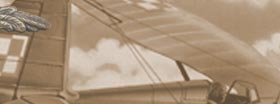Poles, Feluccas, Gibralter & SOE
Introduction:
A motley crew of Poles and Czech’s manned two 20-ton feluccas, the Seawolf (and later joined by Seadog) and Dogfish operating out of Gibraltar by EU/P section of SOE during WWII flying neutral flags of convenience (Portuguese or Moroccan). Foot (1990:126; 2004) described a conversation between Gen. Sikorski and Gubbins where the crew were “too rough even for the Polish navy” and the skippers: Lt. Cmdr. Marian Kadulski (Krajewski) and Lt. Cmdr. Jan Buchowski, both veterans of Narvik who were recklessly brave, operated the ships like a private navy (TNA HS8/ 823; Rankin, 2022) and without the protection of the Geneva Convention 1929. The ships were rough, small, and slow (Dixon, 2020) where there was no space for any leisure activities like deck quoits or sun-loungers for their passengers and therefore making them ideal for clandestine operations navigating the calanques in southern France, but also prone to heavy maintenance in Gibraltar’s naval dockyards. They were able to ferry to and from the south coast of France or North Africa, dropping off stores and agents for F Section of SOE or the Polish section E/UP. A round trip would take possibly between 12-18 days in cramped, claustrophobic, and smelly conditions below deck.
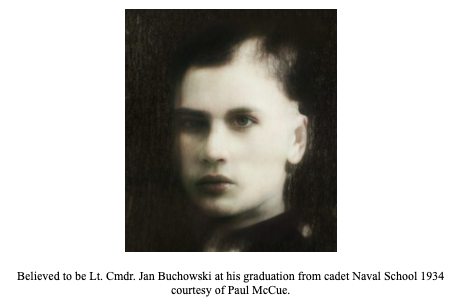
Their prime role was the infiltration and extraction of agents, rescuing allied aircrews who had completed their journey through France in escape lines southwards and assisting others needing to escape from North Africa. General Kleeberg had purchased the Panama for mass evacuations from France and had enlisted a French crew who would sail from Marseilles to Gibraltar and return laden with oranges bought in a Spanish port on the return leg (Słowikowski, 2010). The operation was rumbled by the Vichy police and impounded the vessel. Dogfish was fitted with an engine salvaged from an old car, a Studebaker from HMS Maidstone stores (TNA HS9/231/5) and the other had an engine which seldom worked (Foot, 1990; Rankin, 2017). Seawolf (renamed from Vainqueur and Paquita) was a Spanish fishing boat, commanded by Lt. Cmdr. Buchowski and Krajewski commanded Dogfish, of Moroccan origin. He was responsible for all the Polish seagoing activities in the area including landing agents and evacuating mainly Polish personnel from North Africa (TNA HS4/ 264). EU/P worked with one other fishing boat, Seagull which was on loan from SOE. These missions were a small, specialist area of operations within the overall evacuation of Allied evaders from France and North Africa. Buchowski had already attempted an unsuccessful evacuation in the Casablanca area in December 1941 using the cutter Vega and a planned operation (WARDEN) using Polish sailors to attack enemy ships in the port of Las Palmas on the Canary Islands had been called off after British Foreign Office officials objected to the plan (Grabowski, 2015).
Other operations were working in tandem, mainly through SIS and MI9 regularly using HMS Fidelity (D57 a Special Service Vessel) HMS P36 (U Class submarine sunk later off Malta on 1st April 1942), RNR Tarana (a converted trawler, built in Rotterdam in 1932) and HMS Minna. Seadog was added to the fleet while Seawolf was undergoing a refit in a Spanish dockyard. Karol Durski-Trzasko who was head of the Polish Mission in Gibraltar had arrived from Portugal in the spring of 1941 to command the operations on behalf of II Bureau (Rankin, 2017) that involved 16 officers and 11 lower ranking personnel (Grabowski, 2015).
The greatest contribution of Polish Intelligence from France in 1942 was through reporting Axis troop movements to North Africa from Mediterranean ports in France, Italy, and Sicily (Bennet, 2005) who had several networks both within occupied France and the Vichy. The creation and role of the Vichy government gave the Axis powers greater freedom in launching operations in the Mediterranean with Polish II Bureau setting up networks in Algeria, Tunisia, and Morocco for the exfiltration of Polish POWs and internees in Vichy concentration or labour camps on the orders of Gen. Juliusz Kleeberg in November 1940 (Pepłoński, 2005). Chief of Poland’s Intelligence was Col. Leon Mitkiewicz who had a dislike and distrust of the Vichy regime encouraged the stations based in unoccupied France (Marseilles, Lyon, Nice and Toulouse), Spain, and Portugal to be more active. Polish Intelligence officers had decided to remain in France and assist the escape of Polish personnel still interned in the occupied and Vichy zones and also Switzerland through establishing escape lines early in the war. These escape lines were run by Mieczysław Słowikowski and Jerzy Jankowski (Dominik), head of the Polish Secret Army in France (Pepłoński, 2005; Richards, 2013).
The evacuation of interned Polish soldiers in the Vichy was under the direction of Stanisław Szewalski through SOE’s base in Gibraltar and Oran in Algeria with some support from a clandestine organisation ‘Reseau d’Astier’ and sympathetic French officers (Pepłoński, 2005) with II Bureau taking over operations in the spring 1942. The Polish route through to the south coast of France was preferable despite administrative issues with paperwork and poor management of the evacuation line to Spain. It also avoided Franco’s Republic sympathetic to the Nazis and the location of a notorious concentration camp at Miranda del Ebro. Link: Miranda del Ebro. These holding camps in Vichy were located at Toulouse, Marseilles, Nice and Port Vendres.
In December 1941, Gibraltar was visited by Commander Frank Slocum RN, who was investigating clandestine operations of less well defended beaches in the region (Gregory, 2022). Slocum proposed all special flotilla operations were under the Royal Navy rather than operating independently through SOE and SIS with SOE being subordinate to SIS in these operations (TNA HS8/ 823). On discovering the Poles were already operating independent clandestine operations (under Commodore Durski-Trzasko) much to the annoyance of the Royal Navy who ill-informed Slocum that the operations were not well run, is contrary to documents held within the National Archives. Slocum was the Deputy Director Operations (Irregular) for SIS and had a special interest in secret service sea lanes (Rankin, 2017). The Polish group came under the overall command of the Coast Watching Flotilla (TNA HS4/ 264; TNA HS8/ 823) and was joined by HMS Tarana, a trawler converted to a Q-ship (Richards, 2013; Rankin, 2017). Q-ships were varied in roles ranging from decoys, special operations and ‘mystery’ ships sailing under twin flags and heavily armed. Often used to lure submarines to the surface to attack or used depth charges to sink them. The fleet of feluccas subsequently came attached to the 8th Submarine Flotilla and depot ship HMS Maidstone berthed in Gibraltar harbour that also acted as a repair shop and supplies for the submarine fleet. The command structure was complex and confusing due to the number of agencies involved in the operations making operational life for Krajewski and the Felucca crews difficult (TNA HS8 /823). Interference and changes to planned operations caused problems, particularly when Poles being evacuated from France and North Africa had limitations imposed upon them for no apparent reason (Richards, 2013) and thought it was being treated as a ‘game’ (Peszke, 1999).
Lt. Cmdr. Buchowski completed his duties in Gibraltar seeking a new post in the regular Polish Navy and returned to Britain by air on 21st November 1942. He was recommended for the DSO. He was murdered by Lt. Ludomir Cienski, a jealous husband in London on 12th April 1943 (Richards, 2013; TNA MEPO 3/ 2253), however Cienski was acquitted of all charges. In his book “The Guilty and the Innocent”, William Bixley wrote in 1957 that Cienski, a highly decorated Polish Army Officer, shot Buchowski in a ‘struggle’. With ‘ominous evidence’ and lack of scientific evidence by the Police inadvertently assisted in the acquittal.
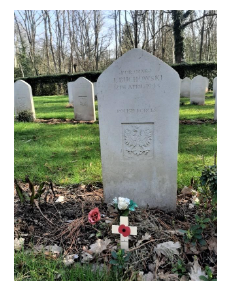
Lt. Cmdr. Jan Buchowski’s grave in the Brookwood Military Cemetery, UK. The granddaughter of Yvonne Rudellat (Jacqueline a courier in the Prosper Circuit), Julie Clamp, regularly places a floral tribute on his grave, as well as one at the Memorial to the Missing where her grandmother is commemorated, whenever she visits Brookwood. Photo courtesy of Paul McCue.
Lt. Cmdr. Kradewski (Kadulski) completed his duties in the autumn 1942. Operation TITANIA was Kradewski's last mission in Seawolf. He returned to England for three weeks' well-earned leave before re-joining his ship, ORP Błyskawica, a GROM class destroyer and a ship later decorated with the Virtuti Militari. His PF in the National Archives appears to have been ‘weeded’ as there few details relating to him remain. Both Lt. Cmdr’s were replaced by Lt. Marian ‘Lukasz’ Michałkiewicz (later awarded the DSC) and Capt. Zohorecki who took over operations in the area until January 1943 (Zamojski, 1981).
Agence Africa and II Bureau
At first glance, Poles running covert operations utilizing Feluccas flying ‘flags of convenience’ out of Gibraltar appears at odds with the Polish contribution to the war effort in Europe and the Mediterranean theatres of war. The answer lies in the role of Agence Africa that has been in the past substantially overlooked and needs its place in history to be re-affirmed to a wider audience and give it credit for the outstanding effort II Bureau made, particularly its role in Operation TORCH, the allied landings in North Africa in November 1942 (Ciechanowski, 2005). Operation TORCH essentially blocked the Axis powers out of northern and western Africa and limiting the ability to launch an attack on the Atlantic coast of the USA from the Mediterranean (Anon, 1942).
By the end of 1940, four Polish intelligence cells of F Station in France had been set up (Bennett, 2005). ‘Tudor’ was in Marseilles, ‘Panhard’ in Lyon, ‘Rab’ in Toulouse and ‘Interallié covering most of occupied France, using Wagon-Lits attendants on the Paris to Marseilles railway line to pass messages. The network had been set up with the knowledge of SIS in London and managed on the ground by Lt. Tadeusz Jekiel (Doctor) who was based in Bordeaux mainly trafficking intelligence on marine activities in Brest, Le Havre and Bordeaux (Marine) and had contacts through Lt. Władysław Potocki (Calixte) with the Vichy government. Tadeusz Jekiel was also responsible for setting up the Italie cell passing on German troop movements on Italian railways. By mid 1944, F Station had 8 stations, 2 independent intelligence stations and 33 cells employing 1,666 agents in France (Pepłoński and Suchcitz, 2005).
Organisational Structure of Résau F2
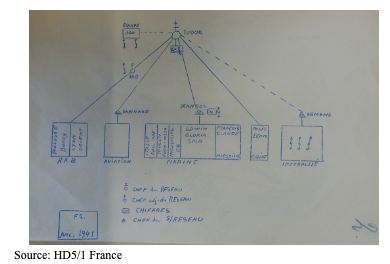
With the fall of France and the signing of the Armistice, Maj. Mieczysław Słowikowski (Rygor) and Maj. Wincenty Zarembski (Tudor) organised intelligence networks and supervised evacuation posts coming into effect by August 1940 (Pepłoński, 2005; Wnuk, 2005; Słowikowski, 2010). By September, the role of evacuation posts was separated from intelligence gathering and was in effect the first Allied intelligence network in France (Wnuk, 2005; Richards, 2010). In occupied France, a secret army mainly enlisting ex-pat Poles into MONICA was put into action. A similar operation ADJUDICATE formed by Count Dziergowski recruited 97 interned Polish troops into sabotage cells that was later compromised (Foot, 2004). Link: Monika & Adjudicate.
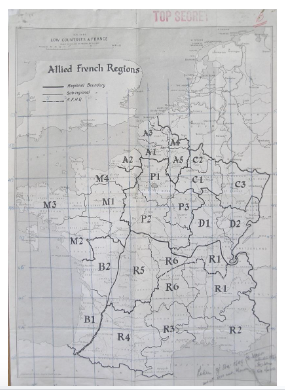
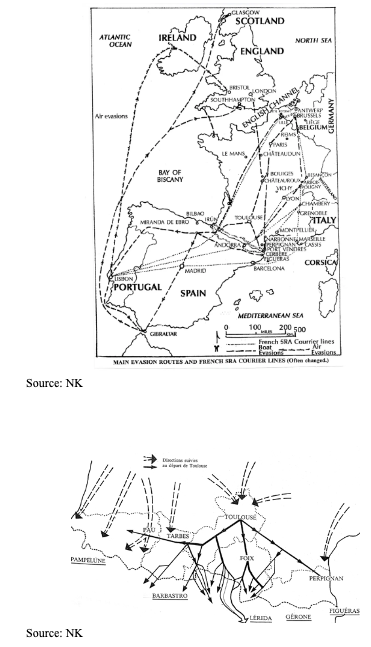
In the spring of 1941, Słowikowski (Rygor) arrived in North Africa to set up a clandestine organisation for obtaining military information through Vichy contacts sympathetic to the Allies at Algiers (Bennett, 2005; Słowikowski, 2010; Rankin, 2017). SIS turned to II Bureau to help develop the network using Poles from Vichy France to set up Station F and Agence Africa which was fully operational by July 1941 with Capt. Jekiel and Lt. Stanisław Rombejko covering Casablanca to Tripoli. While the posts were land-based, Capt. Pierre Lamy captain of the coaster Forfait provided shipping information. Internment and concentration camps were dotted across Vichy North Africa and located within Słowikowski’s network reach. These camps were brutal and stretched from Tunisia to west Africa.
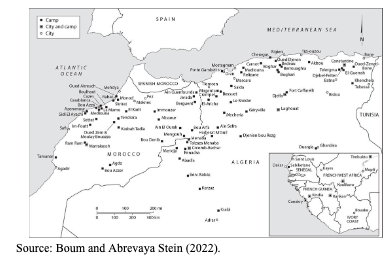
By the time operation TORCH commenced, Agence Africa had outposts in Oran (commanded by Capt. Robert Ragache), Tunis (commanded by Maxime de Roquemaure), Setif (commanded by André Achiary), Algiers (commanded by Maurice Escoute), Philippeville (commanded by Michel Kokoczyński), Constantine (commanded by Paul Schmitt), Bône (Denis Pucheu), Dakar and Agadir (Słowikowski, 2010). According to Stephen Dorril (historian) Agence Afrique “was the most widespread and best Allied intelligence network on the territory of the French North Africa” (Wnuk, 2005: 231). Such was the extent of their network, it played a major role in the planning of Operation TORCH for the invasion of Algeria and Morocco in November 1942 having compiled detailed reports on coastal defence networks, troops deployments and their strength (Pepłoński, 2005; Słowikowski, 2010; Kochanski, 2012).
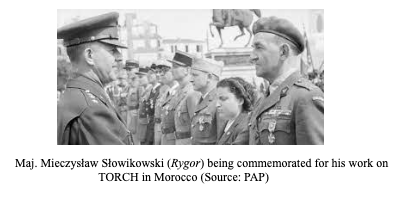
F Station was also tasked to monitor German and Spanish activity as it was thought by SIS that Gibraltar was exposed to potential attack (Wnuk, 2005) and a subsequent report in April 1942 concluded that troop deployments did not reflect this threat.
On 8th November 1942, British and American troops landed in three Vichy French ports: Casablanca, Oran and Algiers who were all locations intelligence cells for II Bureau whose work was recognised by the Allies awarding Słowikowski (Rygor) with some of the highest military distinctions.
Missions
Lt. Cmdr. Kadulski, an experienced naval officer, arrived in Gibraltar in March 1941 just as the planned mass escapes from Vichy France were dropped due to the changing relationships between them and the Poles plus long periods of time awaiting orders via radio and mail (Richards, 2013). This led to alternative plans to collect evaders from Algeria through British representatives (mainly Col. Frederyck Mally) being discussed without the SOE Polish section (EU/P) being informed, placing Kadulski in an impossible position. He was not given an accurate overview of planned missions including the potential for insurrections in the north African Vichy (Brooke, 2013). By July, Kadulski’s frustrations were at a point where momentum in picking up Polish evaders had been partially lost. However, during this period they had eventually prioritized airmen and ‘tankers’ over other services for evacuation. The evacuation posts in Algiers, Casablanca and Oran were later joined by Tangiers and run as an effective network as the missions proved.
The first operation was in a borrowed felucca Seagull from SOE on 3rd August as Dogfish was under repairs. They set off for Casablanca to exfiltrate Poles from the beach and infiltrate Maj. Brzozowski who acted as a courier for Słowikowski’s network.
Lt. Cmdr. Jan Buchowski arrived in Gibraltar on 20th November 1941 with 8 Polish ratings made up of 7 Petty Officers and 1 able seaman for SOE and E/ UP duties. In January 1942, Buchowski started operations in a manned Felucca named Vega (Ville de Fedala). Despite being attached to the 8th Submarine Flotilla, the Poles remained quite independent running missions to the south coast of France (French Scheme) and North Africa, their original priority for missions with little interference, but often contradictory orders.
By mid-August 1942, Lt. Cmdr. Kadulski increased his complaints about interference or obstruction (by Slocum) and the state of the Feluccas with operations being planned without consultation or cancellations, resulting in the Feluccas and crews not being available to meet the increasing demands on the fleet since they were tasked for other operations (Richards, 2013). These operations were effective and became more hazardous when the Germans occupied Vichy France on 10th November 1942. Much of the archive material in the TNA relating to the Polish missions out of Gibraltar are missing or still classified.
******
E/ UP, SOE, SIS and MI9 Missions
The list does not necessarily cover all missions by the feluccas as many operations were solely for SIS, SOE (F Section), MI9 and BCRA and therefore not always included.
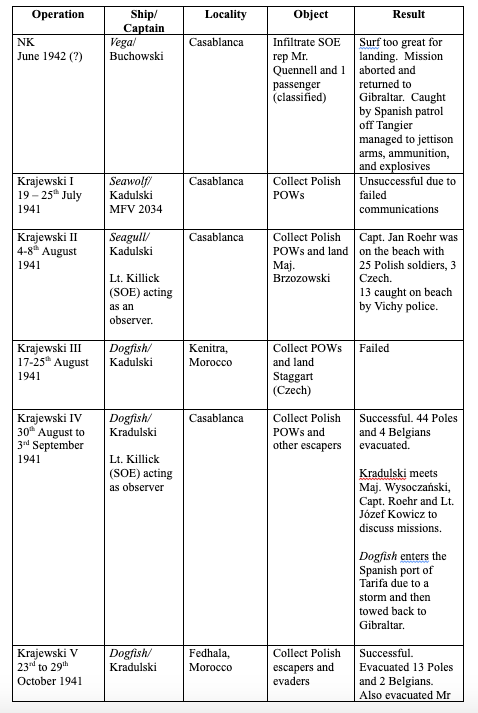
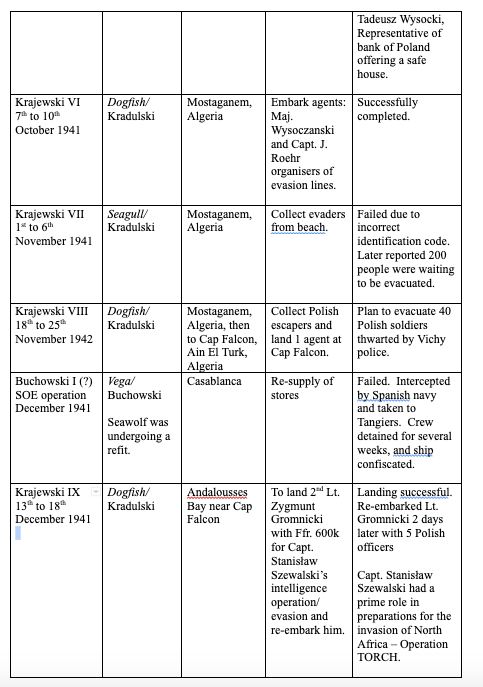
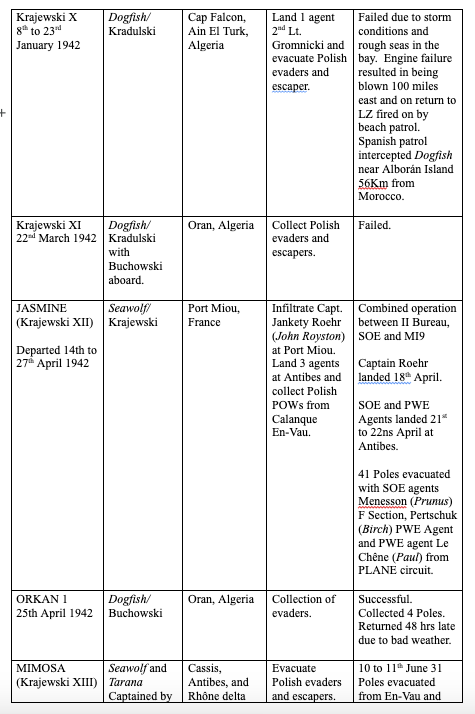
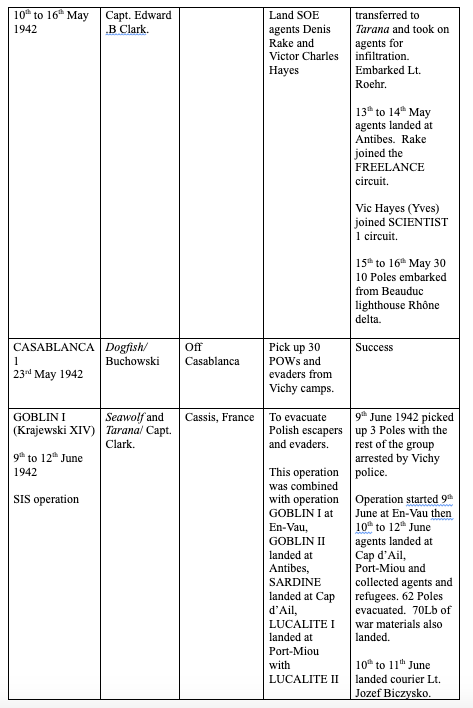
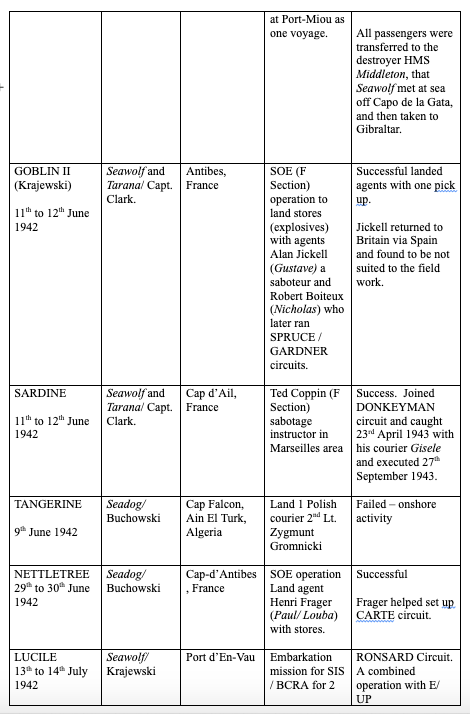
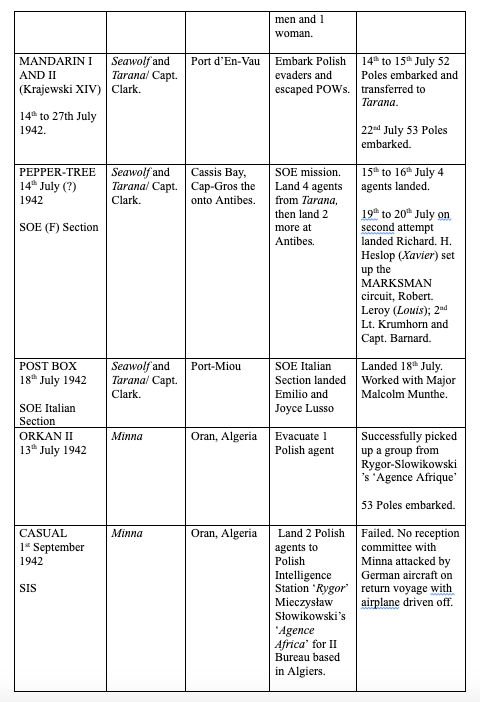
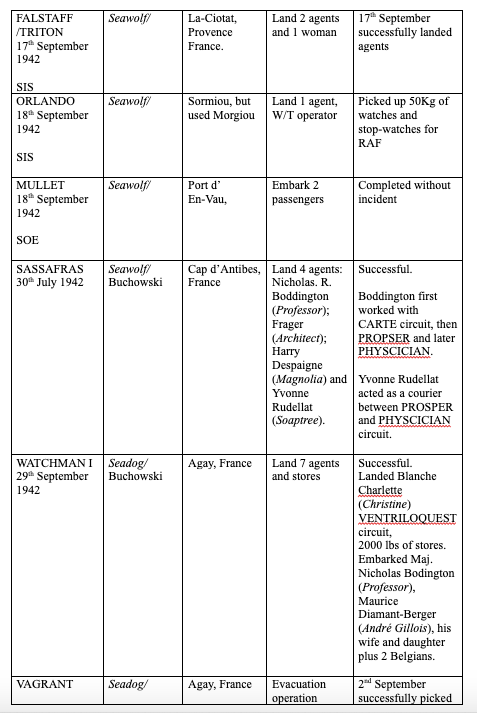
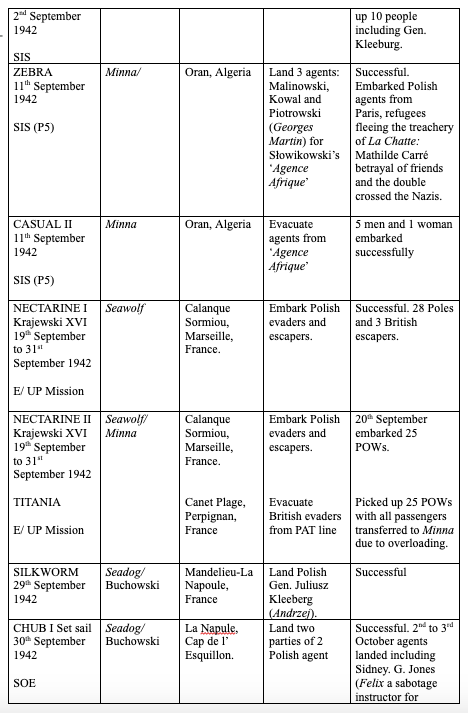
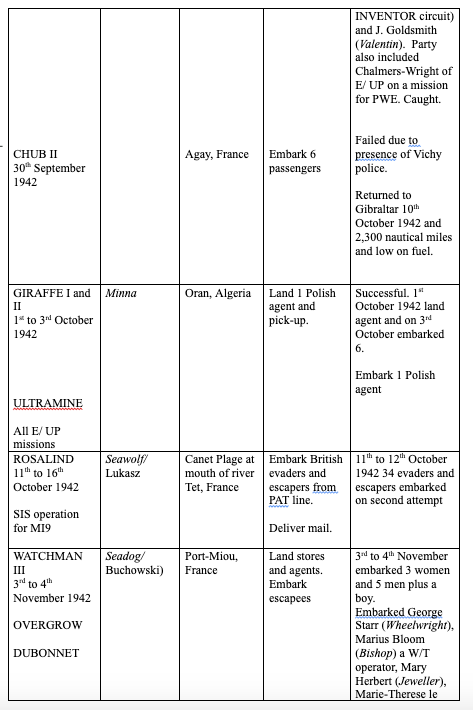
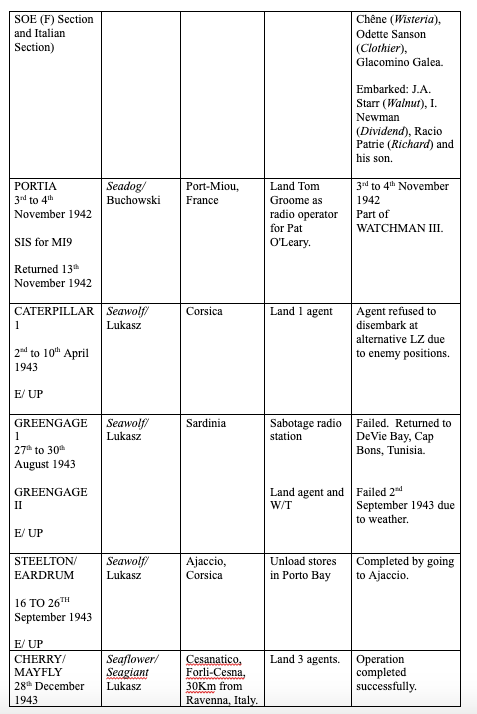
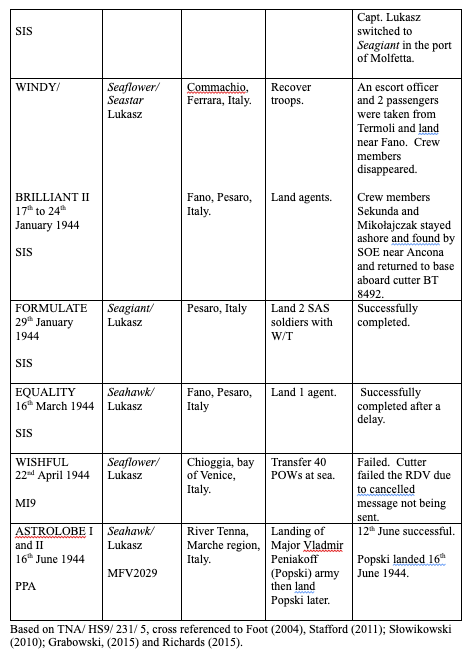
Based on TNA/ HS9/ 231/ 5, cross referenced to Foot (2004), Stafford (2011); Słowikowski (2010); Grabowski, (2015) and Richards (2015).
From mid-October onwards, the Feluccas and Polish sailors were prioritised for SOE, SIS, MI9 and (F) Section operations of which they participated in some 17 missions along the south coast of France (Grabowski, 2015). Operation LADYBIRD was tasked to drop stores for SIS on 2nd December 1942, but failed along with WASP, MELPOMENE, and CRICKET due to weather or lack of pre-arranged signals (Grabowski, 2015).
On 21st April 1943 the Polish Maritime Mission on Gibraltar was transferred to Algiers. (Grabowski, 2015). The Poles had completed 43 secret operations with only 10 being unsuccessful. Over 550 people were evacuated from France and North Africa (Richards, 2013; Grabowski, 2015). In February 1943 the fleet of Feluccas moved to Algeria and then on to Corsica.
and then arrived in Bari on 6th December 1943 to participate in evacuation operations in Yugoslavia until August 1944 (Zamojski, 1981). Seadog and Seawolf (Dogfish was taken out of service in 1942) seemed to have been ‘retired’. Late July 1943, Seadog and Seawolf were on missions for SOE and SIS off Sardinia and the independence of the unit curtailed by complex operational structure and orders. The reduction in operations was in part based on the suitability of the craft for longer-haul missions.
In January 1944 the Polish mission was recomposed under the command of Lt. ‘Lukas’ Michałkiewicz with a ‘cutter’ (not known) being crewed by Mate Ziaja, Senior Seamen: Mikołajczak, Sekunda, Osiński and Fabisiak. In April 1944, the crew were bolstered by Henryk Grzywacz (W/T operator) and Edmund Andrzej Chyc (mechanic), Marian Pietrzycki (mechanic and helmsman), Able seamen Józef Burnas (W/T operator) and Władysław Kuczera, a cook (Grabowski, 2015).
On 15th July 1944 Capt. Stanisław Kince took over the command (Grabowski, 2015) until 1st September 1944. The operation was then taken over by Capt. Kowalik (Czarny, Kowal) and was responsible for the evacuation of Polish officers based in Yugoslavia and Albania and were part of the African Coastal Flotilla (Adriatic Sea). The cutter was deemed to be less useful in the Adriatic waters and replaced by Seaflower (MFV 2041) and twice the size of Seawolf and more adaptable to missions heralding the close of war within this theatre of the Mediterranean. Due to crew shortages, the Poles were seconded to other vessels until British sailors joined them to bolster the crew numbers (Grabowski, 2015).
Grabowski (2015) lists further operations by Poles. This includes 2nd Lt. Stanisław Lukas (Capt. Long) mission to Heraklion on Crete to outpost “Stranger” planned for 11th to 12th September 1944 and landed on 22nd September 1944 in operation VARNISH II (TNA/ HS5 – 724). He was in moved to Chaneá further along the coast and returned on 12th March 1945 working with Force 133 (SOE Section covering the Balkans). On arrival, Crete had almost been completely evacuated by the Germans and his work on repatriation of conscripted Poles into the Wehrmacht was limited (TNA/ HS9 – 948 – 5). On 20th September 1944 another operation landed Capt. Makowski (Benn, Andrzj 2, Tomek 2) on Corfu to then journey to outpost “Edes” south of Ioannina and returned around 12th December 1944. His mission was to search for Poles conscripted into the Wehrmacht and planned to repatriate them into Ander’s Army (TNA/ HS4 - 206) through the repatriation centre in Salonika. On 25th to 26th October 1944 2nd Lt. Antoni Zaleski (Capt. Anthony Glen) (Giewont 2, Sten) was landed at an unknown destination in Greece and was also involved in rounding up Polish conscripts into the Wehrmacht on behalf of Force 133 (TNA/ HS4 – 206) Link: SOE, Poles and the Balkan Connection.
The flotilla base was disbanded in April 1945 and the unit had been liquidated 1st September 1944 with the Polish crews being returned to the Polish Naval Barracks in Devonport, Britain. Grabowski (2015) suggests the disbandment and liquidation of the operation was slightly premature as special Polish units were operating throughout the Balkans assisting guerrilla units or assisting in Poles who had been forced into the Wehrmacht and trying to escape to the Allies who then bolstered Ander’s Army after re-training in Palestine and Italy. Some 35,000 conscripted Poles into the Wehrmacht were repatriated this way.
Link: SOE, Poles and the Balkan Connection.
******
The following table is a list of personnel associated with the Felucca operations.
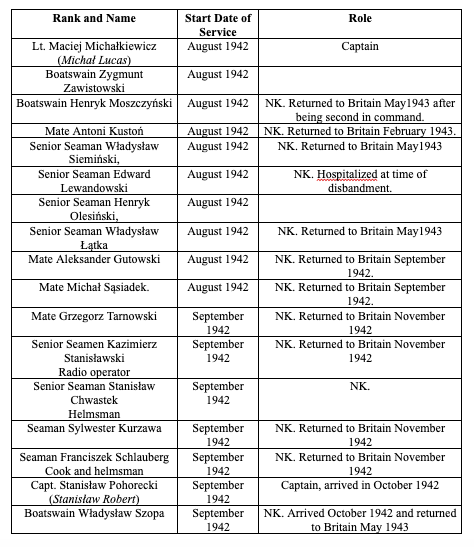
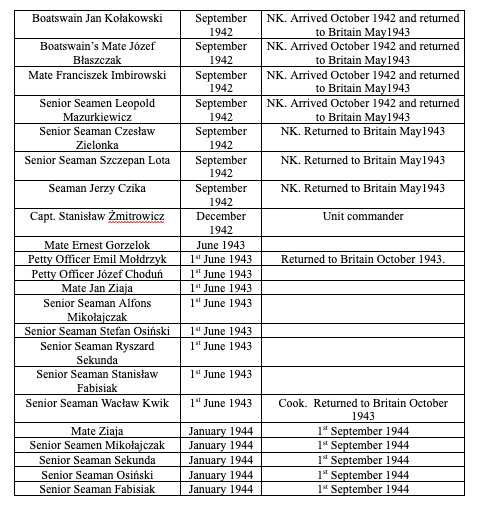
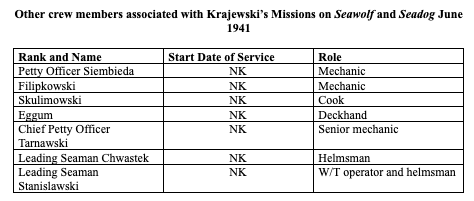

Acknowledgements:
I would like to thank Paul McCue, Julie Clamp, Dr. Steve Kippax and Chris White for their time and assistance in completing this page. Your support and help are deeply appreciated.
Further readings
Anon (1942) “The Landings in North Africa”, Combat Narratives, No.952, Office of Naval Intelligence, U.S. Navy.
Anon (1943) “R v Ludomir Cienski”, The Assizes, Vol.7, Issue 4, pp.263 – 271.
Bennett, G. (2005) “France and North Africa” in Sterling, T; Nałecz, D and Dubicki, T (Eds) “The Report of the Anglo-Polish Historical Committee Vol.1”, Valentine Mitchel, UK, Ch20.
Bixley, W. (1957) "The Guilty and the Innocent: My Fifty Years at the Old Bailey”, Souvenir Press, UK.
Boum, A. and Abrevaya Stein, S. (2022) “Wartime North Africa: A Documentary History 1934 - 1950”, Stanford University Press, USA.
Ciechanowski, J.S. (2005) Literature on the Activities of Polish Intelligence in World War II”, in Sterling, T; Nałecz, D and Dubicki, T (Eds) “The Report of the Anglo-Polish Historical Committee Vol.1”, Valentine Mitchel, UK, Ch5.
Dixon, P. (2020) "Setting the Med Ablaze: Churchill’s Secret North African Base”, Cloudshill Press LLP, UK
Dumais, L.A. (1975) “The Man Who Went Back”, Futura Publications, UK.
Foot, M.R.D (1990) “SOE: Special Operations Executive 1940 – 1946”, Mandarin Paperbacks, UK.
Foot, M.R.D (2004) “SOE in France: An Account of the Work of the British Special Operations”, Routledge, UK
Grabowski, W. (2015) “POLSKA MISJA MORSKA W REJONIE MORZA ŚRÓDZIEMNEGO W CZASIE II WOJNY ŚWIATOWEJ”, Przegląd Historyczno-Wojskowy, Vol.16, No. 67/2, pp. 91-114.
Gregory, D. (2022) “The Global Infrastructure of the Special Operations Executive”, Routledge, UK.
Kochanski, H. (2012) "The Eagle Unbowed: Poland and the Poles in the Second World War”, Allan Lane, UK.
Pepłoński, A. (2005) “The Operation of the Intelligence Services of the Ministry of Internal Affairs (MSW) and of the Ministry of Defence (MON)”, in Sterling, T; Nałecz, D and Dubicki, T (Eds) “The Report of the Anglo-Polish Historical Committee Vol.1”, Valentine Mitchel, UK, Ch11.
Pepłoński, A. (2005) “North Africa”, in Sterling, T; Nałecz, D and Dubicki, T (Eds) “The Report of the Anglo-Polish Historical Committee Vol.1”, Valentine Mitchel, UK, Ch22.
Pepłoński, A and Suchcitz, A. (2005) “Organisation and Operations of the II Bureau of the Polish General Staff”, in Sterling, T; Nałecz, D and Dubicki, T (Eds) “The Report of the Anglo-Polish Historical Committee Vol.1”, Valentine Mitchel, UK, Ch9.
Peszke, M. A. (1999) “Poland’s Navy 1918 – 1945”, Hippocrene Books, USA.
Richards, B. (2013) “Secret Flotillas: Clandestine Sea Operations in the Western Mediterranean, North African & The Adriatic 1940 – 1944”, Whitehall History Publishing / Frank Cass, UK.
Rankin, N. (2017) “Defending the Rock: Gibraltar and the Second World War”, Faber and Faber, UK.
Stafford, D. (2011) “Mission Accomplished: SOE and Italy 1943-1945”, The Bodley Head, UK.
Tillotson, M. (2011) “Secret Army who helped servicemen escape”, The Times, 22nd October 2011.
Słowikowski, M. (2010) “Codename Rygor: The Spy Behind the Allied Victory in North Africa”, Dialogue Books, UK.
Wnuk, R. (2005) “Polish Intelligence in France 1940 – 1945” in Sterling, T; Nałecz, D and Dubicki, T (Eds) “The Report of the Anglo-Polish Historical Committee Vol.1”, Valentine Mitchel, UK, Ch21.
Zamojski, J. (1981) “POLSKA MORSKA AKCJA EWAKUACYJNA Z AFRYKI PÓŁNOCNEJ I FRANCJI DO GIBRALTARU — 1941—1942”, Dzieje Najnowsze, Vol. XIII, No. 1-2, pp. 347 – 368.
Additional Useful Resources:
moroccan-historical-monthly
oatmeal-tycoon-disguise
agencja-afryka
agencja-afryka
NS-184-1998.7-12.pdf
NS-178-1995.7-12.pdf
Haïm, S. (2016) “La résistance du 8 novembre 1942 en Algérie”, Revue d’Histoire de la Shoah, Vol.2, No.205, pp. 385-400.
Krome, F. 1966) “Tunisian Victory and Anglo-American Film Propaganda in World War II,” The Historian, Vol. 58, No. 3, p. 517-29
Medrala, J. (2005) “Les réseaux de renseignements franco-polonais, 1940-1944”, L’Hartmann, France.
Stephens, R; Stephens, S. and Parlour, A. (2007) “In at the Deep End”, Serendipity, UK.
Websites:
secret-ww2.net
conscript-heroes
gibraltar-gateway-to-freedom
polish-navy
SeawolfSeadog
Zamojski.pdf
battle-for-gibraltar
oss-in-action
ww2peopleswar
Slowikowskim
Military History of Gibraltar WWII
historical-poles
herodote
ww2peopleswar
polski
escape gibraltar
ww2escapelines
Selected YouTube.com and Film Resources:
“Casablanca” (1942) Directed by Michael Curtiz with Humphrey Bogart, Ingrid Bergman, and Paul Henreid. Propaganda, a classic or a parody?
“L’Armee des Ombres” (1969) (Army of the Shadows) Directed by Jean-Pierre Melville with Lino Ventura, Paul Meurisse, Jean-Pierre Cassel, and Simone Signoret.
Le Chagrin et La Petié (1969) (Sorrow and the Pity) Documentary directed by Marcel Ophuls.
Le Dernier Metro” (1980) (The last Metro) Directed by François Truffaut with Catherine Deneuve and Gérard Depardieu.
“Les ombres de Casablanca” (In the Shadows of Casablanca) (2009) Directed by Małgosha Gago and Bolesław Sulik, Arte France/ TVN.
“Tunisian Victory” (1944) Directed by John Huston with Frank Capra, Anthony Veiller, Hugh Stewart, and Roy Bolting involved in the production. Featuring Burgess Meredith, Leo Genn and Bernard Miles. Propaganda film.
“Desert Victory” (1943) Directed by Roy Boulting and David MacDonald. British documentary.
https://www.youtube.com/
Jak zostać Genialnym Hultajem? - Mieczysław Rygor Słowikowski. Opowiada Mateusz Pawłowski
www.history.navy.mil
www.youtube.com
www.youtube.com
www.youtube.com
Top of Page
|

